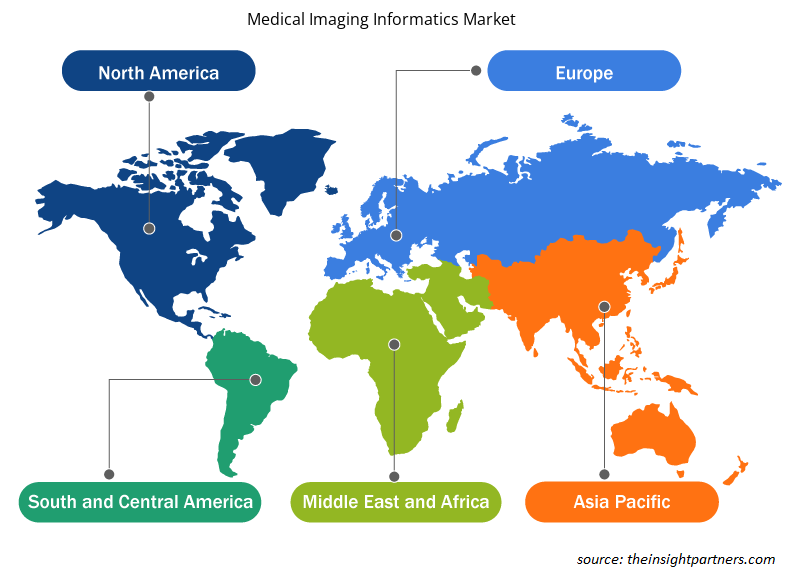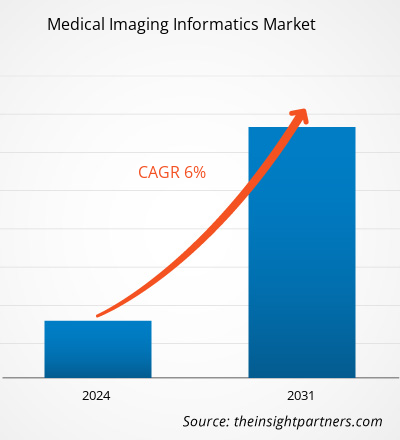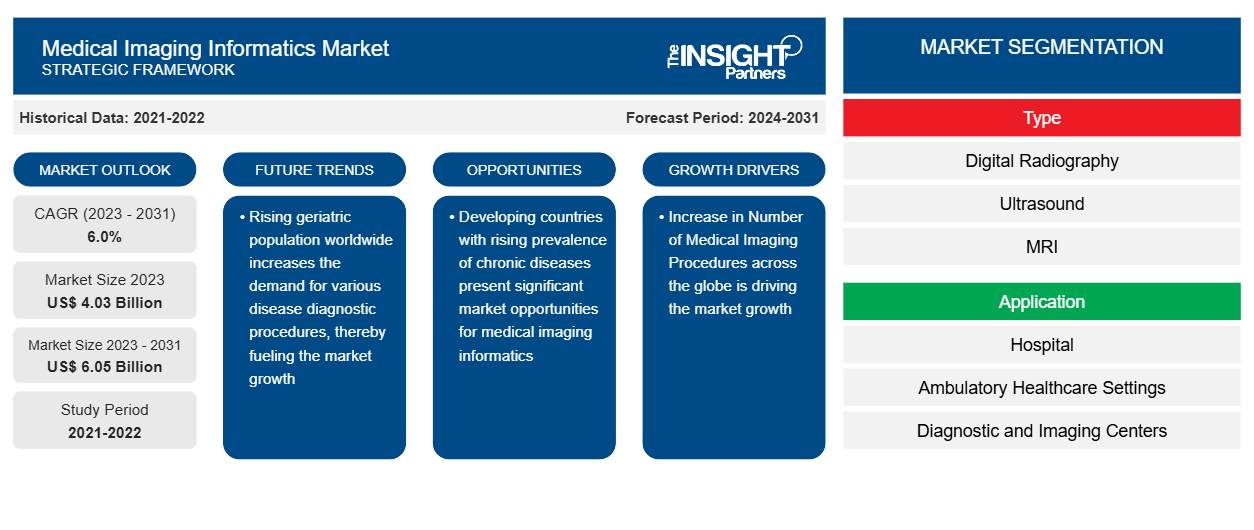Si prevede che la dimensione del mercato dell'informatica per l'imaging medico raggiungerà i 6,05 miliardi di dollari entro il 2031, rispetto ai 4,03 miliardi di dollari del 2023. Si prevede che il mercato registrerà un CAGR del 6,0% nel periodo 2023-2031.La crescente domanda di piattaforme basate su intelligenza artificiale e cloud continuerà probabilmente a essere una tendenza chiave nel mercato.
Analisi di mercato dell'informatica per l'imaging medico
I fattori chiave che guidano la crescita del mercato sono il numero crescente di procedure di imaging medico e l'aumento della popolazione geriatrica. Inoltre, i progressi tecnologici nell'informatica dell'imaging medico hanno creato opportunità di crescita per il mercato nel prossimo periodo di previsione.
Panoramica del mercato dell'informatica per l'imaging medico
Secondo il motore di ricerca clinico Radiology Key, l'informatica per l'imaging implica l'uso della tecnologia informatica (IT) per fornire servizi di imaging medico efficienti, accurati e affidabili all'interno di una rete sanitaria. Chiamata anche informatica radiologica, l'informatica per l'imaging medico è responsabile dell'archiviazione, della gestione e dell'accesso alle informazioni e ai dati correlati alle immagini. L'imaging medico è ampiamente utilizzato in applicazioni di cardiologia, ostetricia, chirurgia e ginecologia, tra le altre, nel settore sanitario. Oltre all'aumento delle diagnosi, una crescente enfasi dei governi regionali e nazionali sulla diagnosi precoce delle condizioni mediche per ridurre i costi sanitari complessivi sta guidando il numero di pazienti sottoposti a risonanza magnetica per immagini (RMI), tomografia computerizzata (TC), ultrasuoni e scansioni a raggi X in tutto il mondo, rafforzando così la necessità di informatica per l'imaging medico.
Personalizza questo report in base alle tue esigenze
Riceverai la personalizzazione gratuita di qualsiasi report, comprese parti di questo report, o analisi a livello nazionale, pacchetto dati Excel, oltre a usufruire di grandi offerte e sconti per start-up e università
-
Scopri le principali tendenze di mercato in questo rapporto.Questo campione GRATUITO includerà analisi di dati che spaziano dalle tendenze di mercato alle stime e alle previsioni.
Driver e opportunità del mercato dell'informatica per l'imaging medico
Aumento della popolazione geriatrica
Regno Unito, Canada, Giappone, Cina, India e Corea del Sud, tra le altre economie, hanno notevolmente modernizzato strutture e servizi sanitari. Di conseguenza, l'aspettativa di vita delle persone in questi paesi è aumentata, portando alla crescita della loro base di popolazione geriatrica. Secondo i dati dell'OMS, nel 2019, il numero di persone di età pari o superiore a 60 anni era di 1 miliardo, destinato a salire a 1,4 miliardi entro il 2030 e 2,1 miliardi entro il 2050. La popolazione anziana soffre principalmente di varie malattie croniche, come le malattie cardiovascolari (CVD), a causa di cambiamenti strutturali e funzionali nei loro sistemi cardiovascolari associati all'invecchiamento. L'invecchiamento porta all'irrigidimento del cuore e dei vasi sanguigni. Pertanto, le aritmie, così come la malattia coronarica e l'insufficienza cardiaca, sono fattori di rischio comuni nelle persone di età pari o superiore a 75 anni. Nell'aggiornamento statistico del 2019 sulle malattie cardiache e gli ictus dell'American Heart Association (AAH), l'incidenza delle malattie cardiovascolari era del 77,2% negli uomini e del 78,2% nelle donne nella fascia di età 60-79 anni. Inoltre, l'incidenza delle malattie cardiovascolari era dell'89,3% negli uomini adulti e del 91,8% nelle donne adulte di età pari o superiore a 80 anni. Pertanto, la crescente popolazione geriatrica in tutto il mondo aumenta la domanda di varie procedure di diagnosi delle malattie e di informatica per immagini mediche, alimentando la crescita del mercato.
Paesaggi sanitari dinamici in Cina e India
I paesi in via di sviluppo come Cina e India presentano significative opportunità di mercato per l'informatica di imaging medico. Con la crescita della popolazione, l'aumento delle spese sanitarie e una crescente prevalenza di malattie croniche, in questi paesi c'è una crescente domanda di tecnologie di imaging medico avanzate. L'adozione di sistemi di imaging digitale e soluzioni informatiche è in aumento in Cina e India, spinta dalla necessità di una gestione efficiente dei dati, una migliore accuratezza diagnostica e una migliore assistenza ai pazienti. In Cina, le iniziative del governo per modernizzare le infrastrutture sanitarie e migliorare l'accesso a servizi sanitari di qualità hanno portato a una maggiore adozione di soluzioni informatiche di imaging medico. La grande popolazione del paese e l'espansione del settore sanitario forniscono un vasto mercato per i fornitori che offrono tecnologie informatiche di imaging avanzate . In India, il crescente numero di strutture sanitarie, unito alla crescente consapevolezza dei vantaggi dell'imaging digitale, sta guidando la domanda di soluzioni informatiche in grado di semplificare i flussi di lavoro e migliorare il processo decisionale clinico. Sfruttando queste opportunità e affrontando le esigenze specifiche di questi mercati, i fornitori possono attingere all'enorme potenziale di crescita offerto da questi paesi in via di sviluppo.
Analisi della segmentazione del rapporto di mercato dell'informatica per l'imaging medico
I segmenti chiave che hanno contribuito alla derivazione dell'analisi di mercato dell'informatica per l'imaging medico sono il prodotto e l'utente finale.
- In base al tipo, il mercato dell'informatica per immagini mediche è la radiografia digitale,ultrasuoni, risonanza magnetica, TC, imaging nucleare, mammografia. Il segmento degli ultrasuoni ha detenuto la quota di mercato maggiore nel 2023.
- In base all'applicazione, il mercato dell'informatica per l'imaging medico è segmentato in base a ospedali, strutture sanitarie ambulatoriali, centri diagnostici e di imaging, altri. Il segmento degli ospedali ha detenuto la quota di mercato maggiore nel 2023.
- In base al componente, il mercato dell'informatica per l'imaging medico è segmentato in base a software, hardware e servizi. Il segmento software ha detenuto la quota di mercato maggiore nel 2023.
Analisi della quota di mercato dell'informatica per l'imaging medico per area geografica
L'ambito geografico del rapporto sul mercato dell'informatica per l'imaging medico è suddiviso principalmente in cinque regioni: Nord America, Asia Pacifico, Europa, Medio Oriente e Africa, Sud e Centro America.
In Nord America, gli Stati Uniti sono il mercato più grande per l'informatica per l'imaging medico. Si prevede che il mercato dell'informatica per l'imaging medico degli Stati Uniti crescerà in modo significativo a causa della crescente prevalenza del cancro, della crescente domanda di imaging diagnostico e della crescente popolazione geriatrica in tutto il paese. Inoltre, si prevede che vari sviluppi realizzati dai principali attori del mercato nel paese e un aumento degli investimenti governativi per promuovere l'industria dei dispositivi medici alimenteranno anche la crescita del mercato durante il periodo di previsione.
Negli Stati Uniti e in tutto il mondo, il cancro ha un impatto significativo sulla società. Le statistiche sul cancro mostrano cosa accade in grandi gruppi di persone e forniscono un'istantanea dell'impatto della malattia sulla società nel tempo. Secondo Globocan 2020, gli Stati Uniti hanno avuto 2.281.658 nuovi casi di cancro, che hanno causato 612.390 decessi. I tipi di cancro più comuni nel paese sono il cancro al seno, il cancro ai polmoni, il cancro alla prostata, il cancro del colon-retto e altri. Pertanto, si prevede che la crescente prevalenza del cancro nel paese alimenterà la domanda di strumenti di imaging medico come ultrasuoni, risonanza magnetica, radiografia digitale e computerizzata, ecc. Anche la domanda di informatica delle informazioni mediche prospererà durante il periodo di previsione.
Approfondimenti regionali sul mercato dell'informatica per l'imaging medico
Le tendenze regionali e i fattori che influenzano il mercato dell'informatica per l'imaging medico durante il periodo di previsione sono stati ampiamente spiegati dagli analisti di Insight Partners. Questa sezione discute anche i segmenti e la geografia del mercato dell'informatica per l'imaging medico in Nord America, Europa, Asia Pacifico, Medio Oriente e Africa e America centrale e meridionale.

- Ottieni i dati specifici regionali per il mercato dell'informatica per l'imaging medico
Ambito del rapporto di mercato sull'informatica per l'imaging medico
| Attributo del report | Dettagli |
|---|---|
| Dimensioni del mercato nel 2023 | 4,03 miliardi di dollari USA |
| Dimensioni del mercato entro il 2031 | 6,05 miliardi di dollari USA |
| CAGR globale (2023-2031) | 6,0% |
| Dati storici | 2021-2022 |
| Periodo di previsione | 2024-2031 |
| Segmenti coperti |
Per tipo
|
| Regioni e Paesi coperti |
America del Nord
|
| Leader di mercato e profili aziendali chiave |
|
Densità degli attori del mercato dell'informatica per l'imaging medico: comprendere il suo impatto sulle dinamiche aziendali
Il mercato dell'informatica per l'imaging medico sta crescendo rapidamente, spinto dalla crescente domanda degli utenti finali dovuta a fattori quali l'evoluzione delle preferenze dei consumatori, i progressi tecnologici e una maggiore consapevolezza dei vantaggi del prodotto. Con l'aumento della domanda, le aziende stanno ampliando le loro offerte, innovando per soddisfare le esigenze dei consumatori e capitalizzando sulle tendenze emergenti, il che alimenta ulteriormente la crescita del mercato.
La densità degli operatori di mercato si riferisce alla distribuzione di aziende o società che operano in un particolare mercato o settore. Indica quanti concorrenti (operatori di mercato) sono presenti in un dato spazio di mercato in relazione alle sue dimensioni o al valore di mercato totale.
Le principali aziende che operano nel mercato dell'informatica per l'imaging medico sono:
- Gruppo Agfa-Gevaert
- Salute Carestream
- SPA ESAOTE
- Elettrico generale
- Koninklijke Philips NV
- Siemens Healthcare GmbH
Disclaimer : le aziende elencate sopra non sono classificate secondo un ordine particolare.

- Ottieni una panoramica dei principali attori del mercato dell'informatica per l'imaging medico
Notizie di mercato e sviluppi recenti dell'informatica per l'imaging medico
Il mercato dell'informatica per l'imaging medico viene valutato raccogliendo dati qualitativi e quantitativi dopo la ricerca primaria e secondaria, che includono importanti pubblicazioni aziendali, dati associativi e database. Di seguito sono elencati alcuni degli sviluppi nel mercato dell'informatica per l'imaging medico:
- Philips lancia nuove soluzioni informatiche potenziate dall'intelligenza artificiale per aumentare l'affidabilità diagnostica con l'intelligenza in ogni fase del flusso di lavoro radiologico presso RSNA (Fonte: Philips, sito Web aziendale, novembre 2022)
Copertura e risultati del rapporto di mercato sull'informatica per l'imaging medico
Il rapporto "Dimensioni e previsioni del mercato dell'informatica per l'imaging medico (2021-2031)" fornisce un'analisi dettagliata del mercato che copre le seguenti aree:
- Dimensioni e previsioni del mercato dell'informatica per l'imaging medico a livello globale, regionale e nazionale per tutti i principali segmenti di mercato coperti dall'ambito
- Tendenze del mercato dell'informatica per l'imaging medico e dinamiche di mercato come fattori trainanti, vincoli e opportunità chiave
- Analisi dettagliata delle cinque forze PEST/Porter e SWOT
- Analisi di mercato dell'informatica per l'imaging medico che copre le principali tendenze di mercato, il quadro globale e regionale, i principali attori, le normative e i recenti sviluppi del mercato.
- Analisi del panorama industriale e della concorrenza che copre la concentrazione del mercato, l'analisi della mappa di calore, i principali attori e gli sviluppi recenti per il mercato dell'informatica per l'imaging medico
- Profili aziendali dettagliati
- Analisi storica (2 anni), anno base, previsione (7 anni) con CAGR
- Analisi PEST e SWOT
- Valore/volume delle dimensioni del mercato - Globale, Regionale, Nazionale
- Industria e panorama competitivo
- Set di dati Excel
Report recenti
Rapporti correlati
Testimonianze
Motivo dell'acquisto
- Processo decisionale informato
- Comprensione delle dinamiche di mercato
- Analisi competitiva
- Analisi dei clienti
- Previsioni di mercato
- Mitigazione del rischio
- Pianificazione strategica
- Giustificazione degli investimenti
- Identificazione dei mercati emergenti
- Miglioramento delle strategie di marketing
- Aumento dell'efficienza operativa
- Allineamento alle tendenze normative























 Ottieni un campione gratuito per - Mercato dell'informatica per l'imaging medico
Ottieni un campione gratuito per - Mercato dell'informatica per l'imaging medico